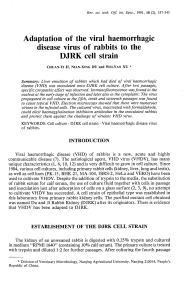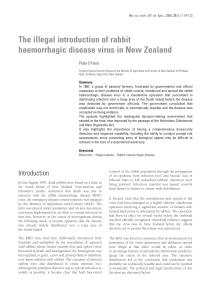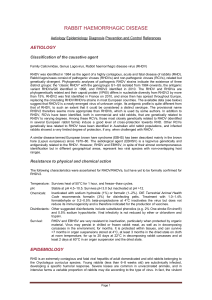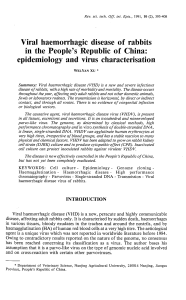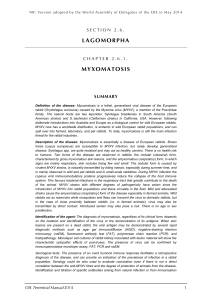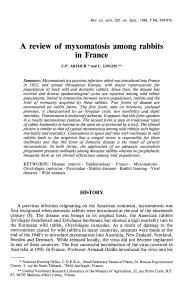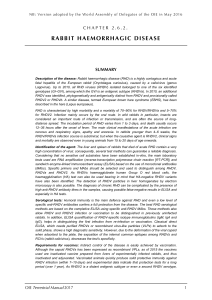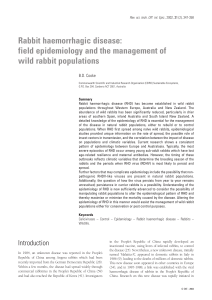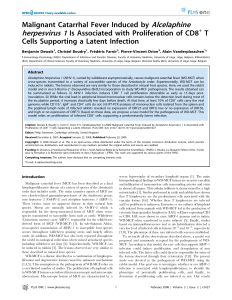D9782.PDF
publicité
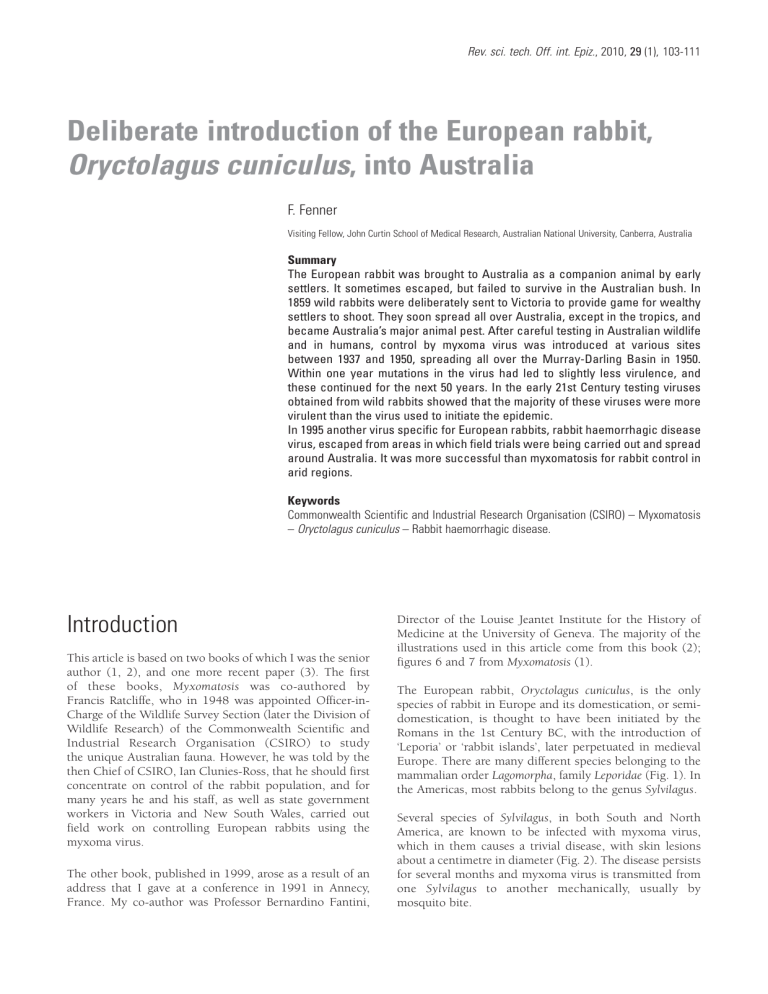
Rev. sci. tech. Off. int. Epiz., 2010, 29 (1), 103-111 Deliberate introduction of the European rabbit, Oryctolagus cuniculus, into Australia F. Fenner Visiting Fellow, John Curtin School of Medical Research, Australian National University, Canberra, Australia Summary The European rabbit was brought to Australia as a companion animal by early settlers. It sometimes escaped, but failed to survive in the Australian bush. In 1859 wild rabbits were deliberately sent to Victoria to provide game for wealthy settlers to shoot. They soon spread all over Australia, except in the tropics, and became Australia’s major animal pest. After careful testing in Australian wildlife and in humans, control by myxoma virus was introduced at various sites between 1937 and 1950, spreading all over the Murray-Darling Basin in 1950. Within one year mutations in the virus had led to slightly less virulence, and these continued for the next 50 years. In the early 21st Century testing viruses obtained from wild rabbits showed that the majority of these viruses were more virulent than the virus used to initiate the epidemic. In 1995 another virus specific for European rabbits, rabbit haemorrhagic disease virus, escaped from areas in which field trials were being carried out and spread around Australia. It was more successful than myxomatosis for rabbit control in arid regions. Keywords Commonwealth Scientific and Industrial Research Organisation (CSIRO) – Myxomatosis – Oryctolagus cuniculus – Rabbit haemorrhagic disease. Introduction This article is based on two books of which I was the senior author (1, 2), and one more recent paper (3). The first of these books, Myxomatosis was co-authored by Francis Ratcliffe, who in 1948 was appointed Officer-inCharge of the Wildlife Survey Section (later the Division of Wildlife Research) of the Commonwealth Scientific and Industrial Research Organisation (CSIRO) to study the unique Australian fauna. However, he was told by the then Chief of CSIRO, Ian Clunies-Ross, that he should first concentrate on control of the rabbit population, and for many years he and his staff, as well as state government workers in Victoria and New South Wales, carried out field work on controlling European rabbits using the myxoma virus. The other book, published in 1999, arose as a result of an address that I gave at a conference in 1991 in Annecy, France. My co-author was Professor Bernardino Fantini, Director of the Louise Jeantet Institute for the History of Medicine at the University of Geneva. The majority of the illustrations used in this article come from this book (2); figures 6 and 7 from Myxomatosis (1). The European rabbit, Oryctolagus cuniculus, is the only species of rabbit in Europe and its domestication, or semidomestication, is thought to have been initiated by the Romans in the 1st Century BC, with the introduction of ‘Leporia’ or ‘rabbit islands’, later perpetuated in medieval Europe. There are many different species belonging to the mammalian order Lagomorpha, family Leporidae (Fig. 1). In the Americas, most rabbits belong to the genus Sylvilagus. Several species of Sylvilagus, in both South and North America, are known to be infected with myxoma virus, which in them causes a trivial disease, with skin lesions about a centimetre in diameter (Fig. 2). The disease persists for several months and myxoma virus is transmitted from one Sylvilagus to another mechanically, usually by mosquito bite. 104 Rev. sci. tech. Off. int. Epiz., 29 (1) a) European hare (Lepus europaeus) b) European rabbit (Oryctolagus cuniculus) c) Eastern cottontail (Sylvilagus floridanus) d) Tapeti or tropical forest rabbit (Sylvilagus brasiliensis) e) Brush rabbit (Sylvilagus bachmani) Fig. 1 Leporids of importance as hosts of viruses of the myxoma-fibroma subgroup of poxviruses Unlike Sylvilagus rabbits, the European rabbit, Oryctolagus cuniculus, lives in very extensive burrows and feeds in the evening. Many still live in the countryside. In medieval times domestication is thought to have been enhanced by French monks seeking a Lenten delicacy, since the newly born or unborn of the rabbit were not regarded as meat. By the 19th Century two or three varieties (e.g. the white ‘Angora’ rabbit) had been developed and maintained by inbreeding. The introduction and spread of rabbits in Australia Most of the very early settlers in Australia were either convicts or police, but by the middle of the 19th Century many well-to-do English people had migrated to Australia. There were a number of wealthy English immigrants who were ardent ‘acclimatisers’, i.e. they introduced familiar species into their new surroundings in an attempt to add variety to what they considered a ‘poor’ environment. A Victorian landholder, Thomas Austin, introduced sparrows, now a pest in Australia, and made several attempts to introduce rabbits to Barwon Park, a sheep station in southern Victoria. Eventually his efforts were crowned with undreamed-of success. The difference between the rabbits brought by early settlers and the rabbits brought in the shipment by Austin on the clipper Lightning in December 1859 was that the latter were wild rabbits, deliberately raised in an enclosed warren (Fig. 3). The rabbits multiplied rapidly, and at a rabbit shoot at Barwon Park in 1867, just seven years after their introduction, Prince Alfred, Duke of Edinburgh, the second son of Queen Victoria, shot 416 rabbits in three and a half hours, helped by officials who changed the guns when they got too hot. The subsequent spread of these rabbits, which soon made them the most important animal pest in Australia, is shown in Figure 4. They did not invade tropical Australia. 105 Rev. sci. tech. Off. int. Epiz., 29 (1) Fig. 2 Lesion produced by the Californian strain of myxoma virus in its reservoir host, Sylvilagus bachmani Some five species of Sylvilagus, in the United States and Brazil, are infected with myxoma virus, all with similar lesions, which persist for several months. Virus is transmitted mechanically by mosquitoes probing such lesions Fig. 4 The spread of rabbits across the mainland of Australia after the introduction of wild rabbits from England to Barwon Park in Victoria in December 1859 The arrow above 1860 indicates the locality of Barwon Park; the ring above 1870 in South Australia indicates the locality of Kapunda, the other centre from which significant spread occurred In the 1880s, in an attempt to limit their spread, vast fences were erected all over Australia, with provisions which were supposed to cope with their habit of burrowing. The most famous was the ‘No. 1 fence’ in Western Australia, which ran from near Esperance on the south coast to Eighty Mile Beach between Port Hedland and Broome in the north (Fig. 5). Everywhere, these barrier fences proved ineffective, not only because they were usually erected after there were rabbits on both sides, but with a burrowing animal such as Oryctolagus cuniculus it was clearly impossible to maintain them at anything like full efficiency. However, fences could be effective on individual farms, if the owners ensured that they were well maintained (Fig. 6). Predation on the wild rabbit in Australia, by dingos, foxes, wild dogs and wild cats (all of which, except dingoes, were introduced after 1788), can be likened to a poor handbrake on a car, which will hold the vehicle on a gentle slope but become less effective after the car starts to move. Myxomatosis Fig. 3 Disworthy Warren near Plymouth, England, showing the artificial mound erected to provide a location for a warren, and part of the wall around the warren Until relatively recently, rabbits were kept within such warrens and periodically harvested; annual crops of up to 100 rabbits an acre were said to be possible By 1863, when the germ theory of infectious diseases discovered by Pasteur and Koch was widely accepted, ‘Hygiene Institutes’, usually associated with universities, were set up in many European countries, including one at Siena, in Italy, with Professor Guiseppe Sanarelli as Director. In 1895, he was invited by the government of Uruguay to set up a Hygiene Institute in Montevideo. In 106 Rev. sci. tech. Off. int. Epiz., 29 (1) Fig. 5 Barrier fences built in Australia between 1880 and 1910 the process of setting up this institute, Sanarelli acquired some domestic European rabbits for the production of immune sera. In 1896 a devastating disease occurred in these rabbits, producing clinical signs quite unlike anything that Sanarelli or anyone else had seen in Europe. The disease was infectious and highly lethal, producing numerous tumours in the skin of infected animals. In 1898 he wrote an account of his investigations, in which he named the disease infectious myxomatosis of rabbits and, unable to find any bacterial cause, suggested that myxomatosis was caused by a member of the newly defined group of infectious agents, the ‘filterable viruses’. In 1909 the disease was reported in European rabbits bought in the local markets in São Paulo, Brazil, and outbreaks have occurred in European rabbits maintained for various purposes in several places in Brazil and elsewhere in South America. It was nearly half a century before the explanation of these ‘spontaneous’ outbreaks was demonstrated by Dr Henrique de Beaurepaire Aragaõ, working in the Oswaldo Cruz Institute in Rio de Janeiro. It was a disease that for many years was thought to be confined to South America, but in 1930 it broke out in commercial rabbitries (which used European rabbits) in California and later in Corvallis, Oregon. The introduction of myxoma virus for rabbit control in Australia Professor H.B. Aragaõ, working in the Oswaldo Cruz Institute in Rio de Janeiro, made two major contributions to the study and use of myxomatosis in Australia. He elucidated the natural history of the disease in Brazil, showing that it was mechanically transmitted by mosquitoes and cat fleas, and in 1919 he brought to the attention of the Australian Government, through Dr A. Breinl, then Director of the Australian Institute of Tropical Medicine in Townsville, the possibility of the deliberate use of myxomatosis for the control of imported European rabbits. The infected tissues sent by Aragaõ were kept under quarantine at the Commonwealth Serum Laboratories, at that time a government institution. However, the initial response of the Australian Government was that: ‘…the trade in rabbits both fresh and frozen, either for local food or for export, has grown to be one of great importance, and popular sentiment here is opposed to the extermination of the rabbit by the use of some virulent organism’. Rev. sci. tech. Off. int. Epiz., 29 (1) 107 Fig. 6 A well-maintained fence designed to exclude rabbits, illustrating the extent to which rabbits ate the grass in the left-hand paddock The possibility of using myxomatosis for rabbit control was raised again in 1924 by Dr H.R. Seddon, Director of Veterinary Research in the Department of Agriculture of New South Wales, but was only used for laboratory experiments, which confirmed the extreme lethality of the disease in European rabbits and the difficulty of transmission by air-borne contagion or contaminated surroundings. No further work was undertaken until 1934, when a Melbourne poliomyelitis specialist, Dr (later Dame) Jean Macnamara, visited Dr Richard Shope at the Rockefeller Institute in New York. Shope was working on the relation between myxoma virus and the serologically similar fibroma virus, and had in his laboratory many European and American rabbits infected with one or other of these viruses. Unaware of Dr Aragão’s previous efforts, but impressed with the possibility of using myxomatosis as a method of controlling Australian wild rabbits, which were by this time the major pest animal in Australia, she wrote a letter to former Prime Minister S.M. Bruce, then the High Commissioner for Australia in London, recommending that it should be tested. The Australian Quarantine authorities were not prepared to allow the virus into the country without experimental evidence of its likely value in practice, but the British agreed to allow a field experiment in the United Kingdom. The Council for Scientific and Industrial Research (CSIRO’s previous name) arranged for Sir Charles Martin, who had retired as Professor of Physiology at the University of Sydney, to go to the Institute of Animal Pathology in Cambridge, England, to carry out field experiments from 1933 to 1936. These led him to state that the virus should be suitable for the control of rabbits in a circumscribed area, and that it appeared to be highly specific for the rabbit. This led to the importation of the virus to Australia so that experiments could be carried out at the CSIRO Division of Animal Health. The results of extensive animal inoculation tests carried out at the high-security Australian Animal Health Laboratory in Geelong, Victoria, confirmed the specificity of the virus for rabbits and dispelled fears that it might adversely affect either domestic or Australian native animals. They also showed that it could be transmitted by a variety of mosquitoes and also by a native stickfast flea. In the 1960s the European rabbit flea, Spilopsyllus cuniculi, was imported into Australia, spread widely, and infected rabbits throughout the year. When quarantine permission was granted for field trials of the virus there were initial difficulties in obtaining suitable experimental sites, largely because of the hostility of those who had vested interests in the rabbit skin and carcass industries. However, co-operation was forthcoming from the South Australian government. Several experiments were carried out, most of them in the dry interior. The most successful was an experiment in which the rabbits, 108 Rev. sci. tech. Off. int. Epiz., 29 (1) living in thirteen large warrens in a 90-acre enclosure, were infested with fleas. The rabbit population was virtually exterminated within two months of the introduction of myxoma virus. However, later experiments proved less successful, and in summing up the work that terminated in 1943 (because of Australia’s involvement in the Second World War), the CSIRO scientists involved concluded that ‘myxomatosis cannot be used to control rabbit populations under most natural conditions with any promise of success’. infectious (whereas myxoma virus was transferred by mosquitoes probing through myxomatosis lesions in rabbits). Probably because of the absence of farmers, many of whom had enlisted in the Australian Army, a very serious rabbit situation developed in Australia in the years immediately following the War. In 1949 CSIRO established a Wildlife Survey Section (later the Division of Wildlife and Ecology) under the leadership of an English scientist, Dr F.N. Ratcliffe, to study the Australian native fauna. However, the Chief of CSIRO, Ian Clunies-Ross, insisted that Ratcliffe should first explore the possibilities of dealing with Australia’s major animal pest, Oryctolagus cuniculus. The effect of myxomatosis on rabbits is shown in Figure 7. As this figure indicates and observations in the field confirmed, myxoma virus, when infecting such large numbers of rabbits, undergoes mutations which make it less virulent. Figure 7a shows a rabbit infected with the ‘standard laboratory strain’, ten days after inoculation; it died later the same day. Figure 7b shows the effects of a mutant strain isolated in December 1952, which led to death on the twenty-eighth day, and Figure 7c shows a rabbit 24 days after inoculation with a strain isolated in 1953; it survived. (For comparison, Figure 7d shows a rabbit inoculated with the Californian strain of myxoma virus, the most virulent strain known, so rapidly lethal that it would rarely have enough skin lesions to be transmissible.) After the war I was invited to join the Walter and Eliza Hall Institute (WEHI) to work with Sir Macfarlane Burnet, who was a virologist. I worked with infectious ectromelia of mice, but I received a scholarship to spend a year at the Rockefeller Institute in New York from 1948 to 1949, where I worked with René Dubos on tuberculosis. While I was there, Sir Howard Florey founded the John Curtin School of Medical Research in Canberra, part of the newly established Australian National University, and he offered me the Professorship in Microbiology. On my return to Australia in 1949, Burnet offered me use of two laboratories in WEHI, since at the time there were no laboratories in Canberra. While I was in New York, workers in CSIRO’s Australian Animal Health Laboratory had shown that myxoma virus was ‘rabbit-specific’ and did not cause disease in any Australian fauna. There had been several more field trials, but it had not spread amongst the then enormous rabbit population. However, in the period between Christmas 1950 and New Year 1951, there was an outbreak that killed millions of rabbits in the MurrayDarling Basin. It was accompanied by an outbreak of a human disease known locally as ‘Murray Valley encephalitis’. The outbreak of this disease, which had long been recognised in northern Queensland, was due to a very wet summer, which caused the southward movement of the Nankeen night heron, an animal reservoir of encephalitis virus. Although careful analysis showed that there was no coincidence in space and time between the two diseases, there was much speculation, in both the medical profession and the media, that encephalitis was caused by myxoma virus. Tests carried out at WEHI showed that encephalitis was caused by a totally different virus, an arbovirus that multiplied in the mosquito before it became I immediately undertook the study of myxomatosis as a virologist, because there were no virologists in CSIRO, and Ratcliffe’s CSIRO group, which was greatly enlarged, carried out most of the fieldwork, which included widespread inoculation of rabbits in various locations every spring and summer. The attenuated strains continued to be useful in the control of rabbits, killing about 50% of infected animals and ensuring that rabbits never reached anything like the numbers that were present before myxoma virus was introduced. Interest in myxoma virus had virtually died out by 1965 when the virus was less virulent, but the number of rabbits had greatly diminished. Fortunately, however, tests of the virulence of field strains were carried out between 1991 and 1994, although the results were not published until 2000. Six isolates from wild rabbits were tested in laboratory rabbits which had never been exposed to the disease. These revealed that one isolate was similar to the attenuated strains found in the 1960s, but the other five were of similar virulence to that introduced in 1950, killing the rabbits in 12 days. Rabbits themselves multiply relatively quickly, and they had also undergone mutations that led to higher resistance. So co-evolution over fifty years had led to a ‘biological arms race’. The use of rabbit haemorrhagic disease virus for rabbit control Rabbit haemorrhagic disease (RHD) virus (rabbit calicivirus, a member of the family Caliciviridae, Fig. 8) was first recognised in the People’s Republic of China in 1984. It spread rapidly throughout Europe and Asia and by 1992 had reached Britain. Typically it causes blood to clot 109 Rev. sci. tech. Off. int. Epiz., 29 (1) b) a) c) d) Fig. 7 Illustration of the appearance of rabbit myxoma virus as originally used and as mutations in the virus diminished its lethality a) Laboratory rabbit inoculated with the ‘Standard Laboratory Strain’, which was used to introduce the virus, ten days after infection; it died later that day. Note the completely closed eyes, the general oedema of the head and the lack of definition of the edges of the primary lesion b) Laboratory rabbit inoculated 21 days earlier with a mutant strain isolated from wild rabbits in December 1952. It died on the twenty-eighth day. The eyes are not completely closed and the primary and nearby secondary lesions are relatively flat and clearly demarcated from the adjacent normal skin c) Laboratory rabbit inoculated with a mutant strain isolated from wild rabbits in 1953, twenty-four days after inoculation. This rabbit recovered. There are numerous secondary lesions and they and the inoculation site are clearly demarcated from adjacent normal skin d) Laboratory rabbit inoculated with the California strain of myxoma virus, seven days after inoculation; it died the next day. This has never been used in the field in Australia Spencer Gulf in South Australia. Although elaborate precautions were taken to try to ensure that it did not escape, in October 1995 it did escape from the island and it was found that rabbits hundreds of miles away were dying from the disease. Fig. 8 Electron micrograph of rabbit haemorrhagic disease virus, a member of the family Caliciviridae in rabbits’ heart, lungs and kidneys and within a few days they die of heart or lung failure. The People’s Republic of China produces rabbits for the local market and has long been the world’s largest exporter of rabbit meat. Studies in the 1990s under high-security conditions in the Australian Animal Health Laboratories showed that, like myxoma virus, it was indeed highly specific for rabbits. After much discussion and agreement, field tests were carried out from 1992 to 1998 on Wardang Island, in Rabbit haemorrhagic disease is usually fatal in Oryctolagus cuniculus, causing death within 48 h to 72 h, with severe disseminated necrotic hepatitis, alveolar oedema and an enlarged and discoloured spleen. There was considerable evidence that insects, particularly flies, were involved in the escape of the virus from Wardang Island and its rapid spread. A number of different species of flies become carriers by feeding on the carcasses of rabbits dying from RHD and their faeces mounds. Blowflies (Calliforra dubia), and other species that enter rabbit burrows and seek out rabbit carcasses, are the most important. Although mosquitoes have been shown to act as vectors in the laboratory, they do not appear to be important in the field. Since flies are much more common than mosquitoes in the dry, arid interior of Australia, they have proved to be a very effective biological control vector for rabbits in areas where myxomatosis was rarely effective. 110 Rev. sci. tech. Off. int. Epiz., 29 (1) Introduction délibérée du lapin de garenne (Oryctolagus cuniculus) en Australie F. Fenner Résumé Le lapin de garenne a été introduit en Australie par les premiers colons, à qui il servait d’animal de compagnie. S’il s’est parfois échappé des lieux où il était maintenu en captivité, il n’a jamais réussi à survivre dans le bush australien. En 1859, des lapins de garenne ont été délibérément introduits dans l’État de Victoria afin de satisfaire les loisirs cynégétiques des riches colons. Ces lapins ont rapidement envahi toute l’Australie, à l’exception des zones tropicales, devenant la principale espèce animale nuisible du pays. Plusieurs tentatives de contrôle biologique recourant au virus de la myxomatose ont été conduites dans différents sites, entre 1937 et 1950, après que des tests minutieux aient été réalisés chez l’homme et la faune sauvage australienne ; en 1950, le virus s’est propagé dans tout le bassin du Murray-Darling. En une année le virus a connu des mutations qui l’ont rendu un peu moins virulent. Au début du XXIe siècle, des virus obtenus sur des lapins sauvages ont été testés et se sont révélés, pour la majorité d’entre eux, plus virulents que le virus qui avait été utilisé pour amorcer l’épidémie. En 1995, le virus de la maladie hémorragique du lapin, également spécifique du lapin, s’est échappé des zones où il faisait l’objet de divers tests de terrain et s’est établi sur tout le territoire australien. Il a été plus efficace que celui de la myxomatose pour maîtriser les populations de lapins dans les régions arides. Mots-clés Maladie hémorragique du lapin – Myxomatose – Organisation de recherche scientifique et industrielle du Commonwealth (CSIRO) – Oryctolagus cuniculus. Introducción deliberada en Australia del conejo común (Oryctolagus cuniculus) F. Fenner Resumen Los primeros colonos que llegaron a Australia trajeron consigo el conejo común como animal de compañía. Aunque algunos escapaban, no lograban sobrevivir en los hábitats de matorral australiano (el bush). En 1859 se enviaron conejos salvajes a Victoria para proporcionar piezas cinegéticas a los colonos ricos. Poco después el conejo ya estaba extendido por todo el territorio australiano, excepto en los trópicos, y se había convertido en la mayor plaga animal del continente. Después de previos y rigurosos ensayos en la fauna salvaje australiana y los seres humanos, el virus de la mixomatosis se introdujo en varios 111 Rev. sci. tech. Off. int. Epiz., 29 (1) lugares entre 1937 y 1950. Ese mismo año se extendió por toda la cuenca del Murray-Darling. En menos de un año el virus había sufrido mutaciones que le restaban algo de virulencia, dinámica que iba a proseguir en los siguientes 50 años. A principios del siglo XXI, al analizar virus procedentes de conejos silvestres se observó que la mayoría de ellos eran más virulentos que el virus que había sido utilizado para desencadenar la epidemia. En 1995 otro virus específico del conejo común, el de la enfermedad hemorrágica del conejo, escapó de zonas de ensayo experimental y se extendió por toda Australia. A efectos de lucha contra los conejos, resultó más eficaz que la mixomatosis en las regiones áridas. Palabras clave Commonwealth Scientific and Industrial Research Organisation (CSIRO) – Enfermedad hemorrágica del conejo – Mixomatosis – Oryctolagus cuniculus. References 1. Fenner F. & Ratcliffe F.N. (1965). – Myxomatosis. Cambridge University Press. Reprinted in 2009, 379 pp. 2. Fenner F. & Fantini B. (1999). – Biological control of vertebrate pests. The history of myxomatosis: an experiment in evolution. CAB Publishing, 339 pp. 3. Ward V.K., Cooke B.D. & Strive T. (2010). – Rabbit hemorrhagic disease virus and other lagoviruses. In Caliciviruses: molecular and cellular virology (G. Hansman, J. Jiang & K. Green eds). Caister Academic Press, Norwich, United Kingdom.
